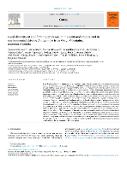| dc.contributor.author | Zádorová, Tereza | |
| dc.contributor.author | Penížek, Vít | |
| dc.contributor.author | Mihaljevič, Martin | |
| dc.contributor.author | Koubová, Magdaléna | |
| dc.contributor.author | Lisá, Lenka | |
| dc.contributor.author | Ettler, Vojtěch | |
| dc.contributor.author | Tejnecký, Václav | |
| dc.contributor.author | Drábek, Ondřej | |
| dc.contributor.author | Pavlů, Lenka | |
| dc.contributor.author | Kříbek, Bohdan | |
| dc.contributor.author | Vaněk, Aleš | |
| dc.contributor.author | Sracek, Ondra | |
| dc.contributor.author | Rojas, Jessica Reyes | |
| dc.contributor.author | Hrdlička, Tomáš | |
| dc.contributor.author | Vokurková, Petra | |
| dc.contributor.author | Mapani, Benjamin | |
| dc.date.accessioned | 2025-01-02T14:11:20Z | |
| dc.date.available | 2025-01-02T14:11:20Z | |
| dc.date.issued | 2025 | |
| dc.identifier.uri | https://hdl.handle.net/20.500.14178/2771 | |
| dc.description.abstract | Local diversity of soil units and properties in a semi-arid tropical climate is controlled by a number of interacting factors, whose contribution to the final form of individual soil characteristics is often difficult to discern. The present study focuses on a detailed assessment of five diverse soil profiles located in the flat foothills of the Otavi Mountains in northern Namibia. A multi-proxy approach consisting of clay mineralogy, micromorphology and geochemical analyses was used to disentangle the drivers of an extraordinary local pedodiversity and to identify the patterns of recent and relict pedogenesis. Significant differences in profile stratigraphy were observed in the soils studied, represented by more weathered Chromic Cambisols and humus-rich soils with mollic horizons (Haplic Phaeozems, Calcic Kastanozem) and vertic features (Vertic Phaeozem). Complex lithology with a dominant influence of unconsolidated sediments of mainly fluvial origin, duration of pedogenesis and subtle changes in local topography and hydric soil regimes were identified as the main factors for the sharp transitions between the patches of each soil group. The studied soils differed significantly in the proportions of clay minerals and iron forms, partly inherited from the allochthonous soil-forming material, and partly developed in-situ. More intensive processes of soil weathering and clay translocation were retarded by limited leaching and base-saturated soil solution. The development of the vertic features was mainly conditioned by the localization of the profile in a minor local depression with prolonged water stagnation and abundance of the finest clay fraction rich in expanding clays. The formation of the thick mollic horizons was probably related to the former dominance of grassland vegetation and further enhanced by stabilization of soil organic carbon by various processes. Specific features that indicate a change in vegetation and a decreasing intensity of redox processes suggest a gradual aridification of the environment in the study region. | en |
| dc.language.iso | en | |
| dc.relation.url | https://doi.org/10.1016/j.catena.2024.108671 | |
| dc.rights | Creative Commons Uveďte původ 4.0 International | cs |
| dc.rights | Creative Commons Attribution 4.0 International | en |
| dc.title | Local diversity of soil forming processes in the semi-arid tropics and its environmental drivers: An example from Otavi Mountains, northern Namibia | en |
| dcterms.accessRights | openAccess | |
| dcterms.license | https://creativecommons.org/licenses/by/4.0/legalcode | |
| dc.date.updated | 2025-01-02T14:11:20Z | |
| dc.subject.keyword | carbon isotopes | en |
| dc.subject.keyword | clay mineralogy | en |
| dc.subject.keyword | micromorphology | en |
| dc.subject.keyword | pedogenesis | en |
| dc.subject.keyword | soil variability | en |
| dc.subject.keyword | Southwest Africa | en |
| dc.identifier.eissn | 1872-6887 | |
| dc.relation.fundingReference | info:eu-repo/grantAgreement/MSM//CZ.02.01.01/00/22_008/0004605 | |
| dc.relation.fundingReference | info:eu-repo/grantAgreement/UK/COOP/COOP | |
| dc.relation.fundingReference | info:eu-repo/grantAgreement/GA0/GA/GA23-05051S | |
| dc.date.embargoStartDate | 2025-01-02 | |
| dc.type.obd | 73 | |
| dc.type.version | info:eu-repo/semantics/publishedVersion | |
| dc.identifier.doi | 10.1016/j.catena.2024.108671 | |
| dc.identifier.eidScopus | 2-s2.0-85212315113 | |
| dc.identifier.obd | 656913 | |
| dc.subject.rivPrimary | 10000::10500::10505 | |
| dc.relation.datasetUrl | https://doi.org/10.5281/zenodo.14272637 | |
| dcterms.isPartOf.name | Catena | |
| dcterms.isPartOf.issn | 0341-8162 | |
| dcterms.isPartOf.journalYear | 2025 | |
| dcterms.isPartOf.journalVolume | 249 | |
| dcterms.isPartOf.journalIssue | February | |
| uk.faculty.primaryId | 115 | |
| uk.faculty.primaryName | Přírodovědecká fakulta | cs |
| uk.faculty.primaryName | Faculty of Science | en |
| uk.department.primaryId | 1063 | |
| uk.department.primaryName | Ústav geochemie, mineralogie a nerostných zdrojů | cs |
| uk.department.primaryName | Institute of Geochemistry, Mineralogy and Mineral Resources | en |
| dc.type.obdHierarchyCs | ČLÁNEK V ČASOPISU::článek v časopisu::původní článek | cs |
| dc.type.obdHierarchyEn | JOURNAL ARTICLE::journal article::original article | en |
| dc.type.obdHierarchyCode | 73::152::206 | en |
| uk.displayTitle | Local diversity of soil forming processes in the semi-arid tropics and its environmental drivers: An example from Otavi Mountains, northern Namibia | en |

